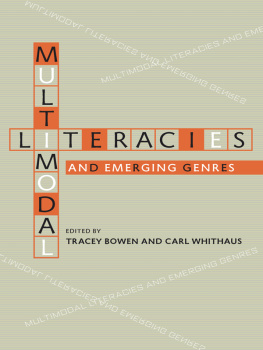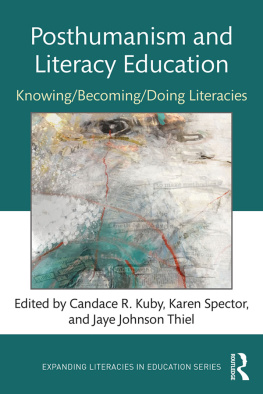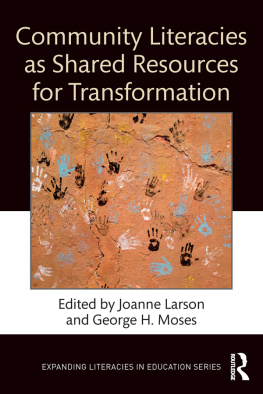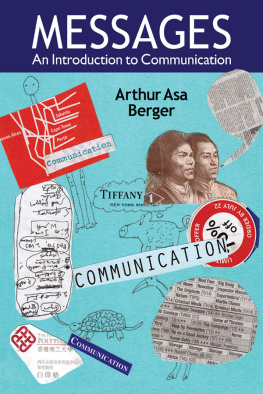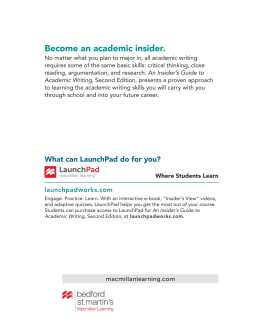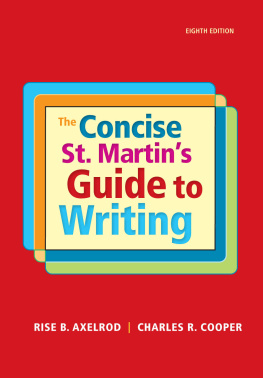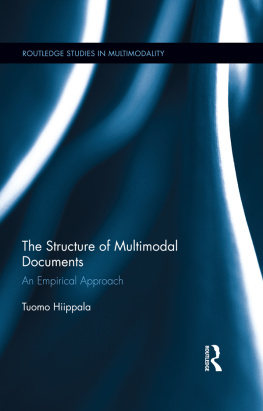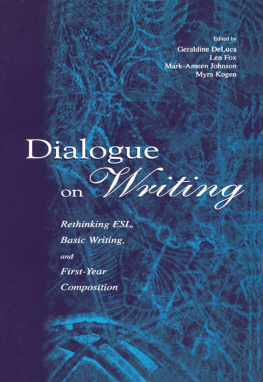ACKNOWLEDGMENTS
THE IDEA FOR THIS COLLECTION had its origin at a Writing Across the Curriculum (WAC) conference at Clemson University a number of years ago. As the book has evolved, we have been privileged to have conversations with many students, teachers, and researchers who are thinking about how multimodal composition is changing what we think of as writing. All the contributors as well as the manuscript reviewers deserve thank-yous. While the complete list of other colleagues who have contributed to the development of our thoughts would go on for pages, we want to acknowledge the special contributions of the following people: Linda Adler-Kassner, UCSanta Barbara; Jonathan Alexander, UCIrvine; Kris Blair, Bowling Green State University; Gail Desler, Area 3 Writing Project; Danielle DeVoss, Michigan State University; Elyse Eidman-Aadahl, the National Writing Project at UCBerkeley; Kory Ching, San Francisco State University; Daniel Gross, UCIrvine; Will Hochman, Southern Connecticut State University; Virginia Kuhn, University of Southern California; Karen Lunsford, UCSanta Barbara; LanetteJimerson, Bay Area Writing Project; Chuck Jurich, High Desert Writing Project; Becky Rupert, Hoosier Writing Project; and Joe Wood, Area 3 Writing Project.
For Carl, the group of graduate students and faculty in the Writing, Rhetoric, and Composition Studies (WRaCS) program at UCDavis have provided a rich series of conversations over the past five years; particular thanks go to Rebekka Andersen, Dana Ferris, Aaron Lanser, Cynthia Carter Ching, Jenae Cohn, Jeff Magnin, Sandra Murphy, Sarah Perrault, Tara Porter, Manuel Senna, Aparna Sinha, Mary Stewart, Chris Thaiss, and Juliet Wahleithner. Of course, a coedited book requires two to tango, as they say, and Carl would like to thank Tracey for the e-mails and phone conversations that kept this project going. Thanks are also due Carl's familyShannah, Lillian, Hannah, AJ, and Rosaleefor putting up with him and for providing much multimodal inspiration (Facebook, tweets, tumblr, and beyond).
Tracey would like to thank Cleo Boyd, of the Robert Gillespie Academic Skill Centre, for her continuous support of multimodal pedagogical adventures; Penny Kinnear for her constant collaboration and her willingness to use her writing classes as a place for visual experiments; and all the students in CCT310 Mass Communications and Popular Culture at the University of Toronto Mississauga for taking up the multimodal challenge and pushing their imaginations. Tracey would also thank Carl for his ongoing enthusiasm, his collaborative spirit, and his commitment to this project. Finally, Tracey thanks her husband, Robert, for his boundless love and support.
CHAPTER 1
Genre and Transfer in a Multimodal Composition Class
Cheryl E. Ball, Tia Scoffield Bowen, and Tyrell Brent Fenn
IN SOME OTHER CHAPTER, IN some other collection, a teacher writes about how great her semester went teaching a new syllabus that seemed to have worked extraordinarily well. She details that syllabus and discusses how the assignments were sequenced; she concludes by providing quotes from the students' portfolio reflections to show that they learned a great deal from the class, from her. The reflections would say things like:
When I was a child, I was fascinated by technology. I had an 8-bit Nintendo, built my own computer, and generally geeked out when it came to science and technology. But I wasn't always interested in this stuff. Personally, I blame Ender. I don't know who introduced me to the science fiction novel Ender's Game, but whoever it was inadvertently sparked my love for books, science, and technology. Working on the documentary in English 3040 reminded me of my early school years and my love of technology as a form of expression. As a kid I had a wild imagination, and as a senior in college [when I took 3040] I had a lot of ideas to express. Technology,writing, and good teachers gave me a way to do it. (Excerpt from Tyrell Fenn's design justification, December 2006)
Insert the teacher's glowing reflection of the class and the student. Then the teacher would insert another student reflection, this time moving the argument along toward the multimodal bit she was intending:
Growing up, I was determined to be an inventor. What I wanted was for people to crowd my little cul-de-sac just to get their hands on the only decorative mud-ball in town. But since nothing I created had a significant impact on society, I quit the idea and my inventor dreams seemed to be doomed for good, until this class came along, giving me the option to dabble for a grade. My perspective of inventing has grown: Now my idea of invention is still tied to what's important to me right now, but how I invent something to fill that need has changed. For instance, unlike my older sister, who writes and writes and writes in her journal, I get overwhelmed by journal writing, but I love to reminisce and hold onto memories, so camcorders and pictures became my journals. Before I learned how to use programs that made slideshows, I would line pictures up next to each other on the floor, turn on a song in the background, make sure cell phones and pagers were turned down, turn on my parents' oversized camcorder, and record each picture manually. Watching them now, it's comical, but then I thought it was brilliant. (Excerpt from Tia Scoffield Bowen's design justification, December 2006)
That, however, is not this chapter. It would have been if written several years ago. Now, the then-brilliant reflections by the teacher seem comically nave. She is not such a n00b (newbie) anymore to think that that imaginary version of this chapter would still have been accurate. Instead, this chapter is about a once-upon-a-time, newish tenure-track teacher who misplayed a crucial teaching moment, which spiraled into a misuse of genre, and how she learned to recover and resituate her teaching-research with a genre studies approach. And the students (Tia Scoffield Bowen and Tyrell Fenn) are not trapped in some time-independent student status where their design justification statements represent a stagnant contribution to multimodal research. This chapter is now a coauthored piece written by two once-upon-a-time students and their somewhat nutty teacher. All three have moved on from the English 3040 course at Utah State University, and all three have continued to work in multimedia fields. This chapter synthesizes the experience of a multimedia composition course and asks how concepts of genre transfer across multiple boundaries.
A MULTIMODAL COMPOSITION CLASS
The course catalog description for English 3040, Perspectives in Writing and Rhetoric, is an in-depth study of rhetoric and writing for non-majors (Peterson 200910, 549). Over the three years Cheryl taught this course at Utah State University, she treated it like a special topics class in different forms of multimodal composition, and the genres that students produced were expansive:
(a) websites (i.e., religious travelogues of missionary trips, commercial sites promoting student-run businesses, genealogies, an intranet training site for a local veterinarian's office, and promotional sites for student clubs);
(b) literary hypertexts (poetic, prosaic, and imagistic); and
(c) videos (documentaries, poems, remediated research papers, visual argument slideshows, music videos, etc.).
The course topicdigital narrativesfor the fall 2006 term in which Tyrell and Tia were enrolled was purposefully vague because Cheryl did not want students to have to choose from a narrow set of genres as they had done for the e-literature version of the course. Narrative left the generic option open, because Cheryl's hope was that students would produce a range of genres as well as multigenre texts.

